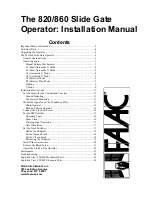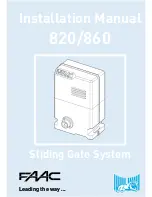
12
13
5 - ADJUSTMENT OF THE RECIVER / OPERATING MODES
AUTOCHECK PERIOD
OPERATING MODE WITH OPTICAL SAFETY EDGES
ATEST SIGNAL POLARITY (depends on the control panel)
INHIBITION POLARITY
SW1
SW2
SW4
SW3
7 s
ON
Negative
30 s
WORK
Positive
Close
contact
Open
contact
The system performs a complete test of the equipment, including
radio communication.
In ON mode, only "always on" optical safety edges (OSE-S7502) are
permitted, as the optical element always is on.
In WORK mode, the optical elements are OFF meanwhile the ATEST
signal is active. So it is necessary to disconnect this ATEST signal
during the gate movement.
ATEST negative: ATEST signal is a fixed 12 or 24V signal that the
control panel sets to 0V to make the system check.
ATEST positive: ATEST signal is disconnected and when the control
panel makes a test it provides a 12 or 24V signal.
Open contact in “INH-GND” connector switches off NO TOUCH
detector.
Close contact in “INH-GND” connector switches off NO TOUCH
detector (CAP MAGIN)
CAP R868/916 receiver can work with standard RB3 transmitters and new CAP ACTIVE/CAP T transmitter
(NO-TOUCH function) at the same time.
Inhibition input (switch on and off the NO-TOUCH function) will affect all CAP ACTIVE/CAP T transmitters
in the same way. It does not make any difference between safety edge on opening nor on closing.
CAP ACTIVE / CAP T transmitter has 2 separate detectors, mechanical / resistive safety edge and NO-TOUCH
function. Both program together and at the same time as if they were a single safety edge on the receiver. It is
necessary to see the LED indicators on CAP ACTIVE / CAP T to know which kind of technology is either detecting
a collision (safety edge) or prevent the collision (NO-TOUCH function)
In the case of operating without ATEST signal, it is necessary to work with ATEST set to positive. In order to comply
with the EN ISO 13849-1: 2008 safety standard, you must connect this signal to test the system.
ON/WORK mode
The operating mode is selected by the SW2 of the receiver. This selector is necessary when working with optical
safety edges. All transmitters in the receiver work in the same way.
It will be necessary to reset the receiver when
changing the operating mode with transmitters already memorised
.
With
standard optical safety edges
, WORK mode must be used due to high consumption of the optical elements.
With
OSE-S7502 "always on" optical safety edges
, both modes are allowed. In ON mode, the system becomes
universal for any control panel. In WORK mode the battery life is maximized thanks to the shutdown of the optical
elements.
Before programming, place the options selectors at the
desired position. Any subsequent change will require a
receiver reset and reprogramming.
Press the PROG button on receiver and hold it until the
desired mode is selected. LED's for R1 & R2 will light up or
flash in sequence to select the correct operation mode.
There are
four programming modes
, depending on the
inputs you wish to use of the transmitter and the outputs
required to activate on the receiver.
The receiver allows the programming 6 safety edges
(3 for Relay 1 and 3 for Relay 2). A safety edge can only
be programmed to one receiver.
6 - PROGRAMMING
6.1 - PROGRAMMING SAFETY EDGE TO RECEIVER
CAPTIVE
CAPTIVE
MODES
1
2
3
IN1
Safety edge in IN1 on transmitter activates R1 on receiver
IN1
Safety edge in IN1 on transmitter activates R2 on receiver
IN1
Safety edge in IN1 on transmitter activates R1 and R2 on receiver
R2:
R1+R2:
R1
4
In case of CAP ACTIVE/CAP T, safety edge is IN1 and
NO TOUCH function is IN2
EN
EN
Safety edge in IN1 on transmitter activates R1 on receiver
and Safety edge in IN2 on transmitter activates R2 on receiver
R1
and
IN2
R2:
IN1










































